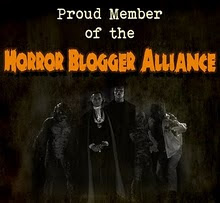
Synopsis: Artist David Stuart (Lon Chaney, Jr.) is working on the painting that he believes will be his masterpiece, the one that will establish him as a serious player in the art world. It's a portrait of an exotic model named Tanya Czoraki (Acquanetta) dressed in what what we must accept, for the purposes of this film, as traditional Latin American garb.
Men are constantly putting the moves on the sultry Tanya, but she isn't buying. It seems that Tanya spends a lot of time in Stuart's loft, posing for his masterpiece, and she has fallen in love with him.
Stuart himself doesn't seem aware of this. He only has eyes for his hatchet-faced fiance Heather Hayden (Jean Parker). Heather's a swell gal, and she wears a lot of interesting hats. As if that weren't enough, her family loves him, particularly Heather's father, whom Stuart has taken to calling "Dad Hayden".
Whenever he takes a break from his painting, Stuart likes to soothe his eyes with gauze pads soaked in a boric acid solution, which he inexplicably keeps in a bottle on a high shelf right next to a nearly identical bottle containing highly corrosive acid. Because Tanya has moved the bottles around on the shelf while looking for something else, Stuart doesn't realize that on this occasion he's just soaked his gauze pads not with boric acid but with, well, acid.* As a result, his corneas are burned and he is now blind. The doctor tells him that a cornea transplant might succeed in restoring his sight, but then again it might not; in any event, donors are scarce and they are unlikely to ever find one.
His career in ruins, unable to complete his masterpiece, Stuart is morose and self-pitying, but he still refuses to blame poor Tanya, who feels terrible about it. Believing that Heather continues to stay with him out of pity for a blind man, Stuart nobly breaks off the engagement. When Heather presses him for a reason, he lies to her, insisting that he's in love with Tanya.

Dad Hayden refuses to give up on Stuart, and tells him that he has willed his own corneas to Stuart upon his death.
But when Heather arrives home a few nights later she finds Dad Hayden lying dead on the floor. Standing over the body is Dave Stuart, with blood on his hands....
Comments: This is the fourth of the Inner Sanctum mysteries that we've seen on Horror Incorporated, and by now the formula for these movies should be quite clear. Once again we're asked to believe that Lon Chaney, Jr. is a babe magnet; once again he is accused to committing a brutal murder; and once again the question of his guilt or innocence is the pivot upon which the story turns.

Inner Sanctum mysteries tend to pile on the plot contrivances, and Dead Man's Eyes is no exception. Arranging the circumstances of Stuart's blindness in such a way as to make us wonder about Tanya's complicity has forced screenwriter Dwight V. Babcock to reach, with trembling hands, for the very highest bottle on the storytelling shelves. But no matter how you slice it, any guy who keeps his eyewash and his corrosive acid in matching bottles right next to each other is just asking for trouble.
The script is full of clumsily rendered coincidences and red herrings, all designed to keep the viewer off balance. In spite of this, it isn't difficult to figure out who the real murderer is and, more importantly, who the real murderers aren't.
Lon Chaney, Jr. deserves credit for the thankless task of carrying another Inner Sanctum trifle. But the truth is that in most of these films Chaney is simply too old for the character he's playing. Part of this is Chaney's appearance -- he simply looked a good deal older than his 38 years -- but it's also clear that David Stuart, as written, is supposed to be much younger than 38 (though no movie's casting could be crueler than that of Earthquake (1974) in which we're asked to believe that 50-year-old Charlton Heston is an up-and-coming architect married to the boss's daughter, played by 51-year-old Ava Gardner).
Aside from the usual faces from the Universal acting bullpen, we must also pause to consider the presence of Venezuelan model Acquanetta, playing the role of Tanya. I will go easy on her performance in Dead Man's Eyes, because to pillory the poor woman, even 60+ years later, seems like kicking a puppy. After all, it isn't Acquanetta's fault that some deranged producer got it into his head that she could be a star; nor is it her fault that, frankly, she has no talent.
Yep, she's bad all right -- not low-budget-Universal-contract-player bad, but really bad. High school theater bad. Ed Wood Productions bad. She reads her lines as if reciting from a book of traffic ordinances. The woman is a knockout, but she doesn't radiate any presence at all, certainly not the hungry sensuality that everyone in the movie ascribes to her. To paraphrase the immortal Libby Gelman-Waxner, Acquanetta could not convincingly scream for water if her hair was on fire.
But she carries on gamely, as everyone in the movie does; and in its way Dead Man's Eyes is likable enough: not ambitious or flashy, but it kills 65 minutes, and if you've had a few drinks you might even enjoy it.
But then, you could say that about a lot of things.
__________________________________
*Acetic acid, to be precise. A 5% solution of acetic acid is better known as table vinegar, and mixed with a little olive oil it makes a delicious salad dressing. But in its undiluted form it's highly corrosive, quite capable of burning your eyes out of your head if you treat it carelessly -- as Dave Stuart clearly does.









